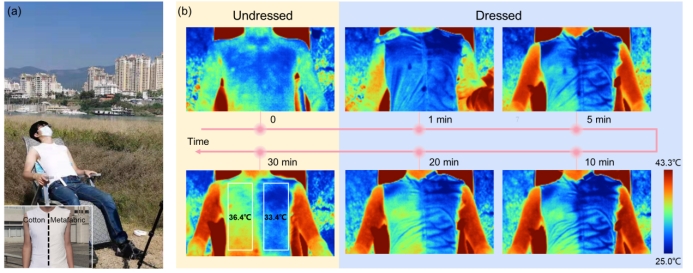On July 8th, a paper titled Hierarchical-morphology metafabric for scalable passive daytime radiative cooling was published by Prof. Tao Guangming’s research team under Wuhan National Laboratory for Optoelectronics, Huazhong University of Science and Technology. The paper was published jointly with Prof. Ma Yaoguang’s research team under the College of Optical Science and Engineering, Zhejiang University.
Via classic industrial textile manufacturing routes, research teams innovatively prepared a wearable and scalable metafabric based on a random metamaterial with hierarchical-morphology structure. Randomly dispersed scatterers of hierarchical sizes are distributed in different locations throughout the layers of the metafabric, providing an average emissivity of 94.5% in the atmospheric transparent spectral window (ATSW, λ ~8-13 μm) and a reflectivity of 92.4% in the solar spectrum (0.3-2.5 µm), which offered an extended spectroscopic response that spans two orders of magnitude and enabled the metafabric to resonantly reject the solar power and strongly emit in the mid-infrared (MIR) range. The highly cost-effective and high-throughput metafabric is viable to be commercialized in the near future, serving as an effective personal thermal management (PTM) vehicle to protect people from the intensifying global climate change.
To validate the cooling performance of the metafabric with scalable, wearable features in pragmatic scenarios. A volunteer wearing a vest (consisting of a commercial cotton fabric and a metafabric) reclined under direct sunlight for an hour while the thermal properties of the vest and the volunteer were monitored. A thermal camera showed a large temperature difference between the two sides of the vest. Thermocouples adhered under the vest also indicated a temperature difference of ~4.8 °C between the parts of the body that were covered by different fabrics. A similar test for the radiative cooling vest was performed in Sipsongpanna, China for repeatability (Fig. 1A). During the half-hour measurement process, the surface of each half of the vest gradually exhibited a notable temperature difference (Fig. 2B). Amazingly, the two halves of the body showed a distinct temperature difference of more than 3 °C right after the vest was removed.

Fig. 1 | (a) Photo of the metafabric cooling tests on the human body. (b) Infrared images of the volunteer under direct sunlight in Sipsongpanna, China (22°10′22″N, 100°51′29″E, December 13, 2020).

Movie 1 | Infrared video of human body under direct sunlight for half an hour in Sipsongpanna, China (22°10′22″N, 100°51′29″E, December 13, 2020), which shows the remarkable cooling effect on the human body.
In addition, the team tested the cooling performance of the metafabric with 3 car models covered by a commercial vehicle cover, the metafabric, and nothing, respectively. During a 90-min experiment, the maximum interior temperature of the car model covered by the metafabric was ~30 °C and ~27 °C cooler than that of the models with no cover and with a vehicle cover (Fig. 2). These results show the great potential for commercial applications in various complex scenarios, such as smart textiles, sunshade products, logistics transportation, etc.

Fig. 2 | Temperature test curves of three identical car models exposed to the sun. The inset shows photographs and IR images of the car models during the three time periods. “I” and “III” labels correspond to the initial and final measurements, respectively, and “II” shows a photograph of the whole test process. Scale bar, 10 cm.
Inspired by the interdisciplinary innovations of nanooptics and functional textiles, this research bridged the gap between different disciplines and created a viable strategy for the large-scale manufacturing of the metafabric. Compared with passive cooling routes like films or paints, the woven structure enables metafabric to easily accommodate complex deformations, which leads to versatile compatibility. This work may enable new applications and uncover new perspectives in the fields of thermal management, intelligent garments and personal healthcare.
The research team has been engaged in hierarchical-morphology metafabric studies for three years, and has gradually realized the goal of pushing scientific research to industrial application. Prof. Tao has published over 60 peer-reviewed papers in international science journals, such as Science (1), Nature (2), Proc. Natl. Acad. Sci. (2). He has over 20 granted patents and over 60 pending patents. The Center for Advanced Functional Fibers (CAFF), led by Prof. Tao, is committed to interdisciplinary research work, such as multimaterial specialty optical fibers, flexible medical fiber robots for intracavitary minimally invasive precise surgery, and intelligent fabric technologies for healthcare scenes. Zeng Shaoning, a master student at Huazhong University of Science and Technology; and Pian Sijie, a doctoral student at Zhejiang University, are the co-first authors of this paper. Prof. Tao Guangming of Wuhan National Laboratory for Optoelectronics, Huazhong University of Science and Technology, and Prof. Ma Yaoguang of Zhejiang University are co-corresponding authors. This work was supported by the National Natural Science Foundation of China.
Written by: Tao Guangming, Zeng Shaoning, Gou Bingbing
Edited by: Andrew, Peng Yumeng
